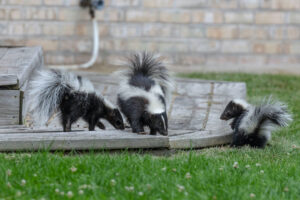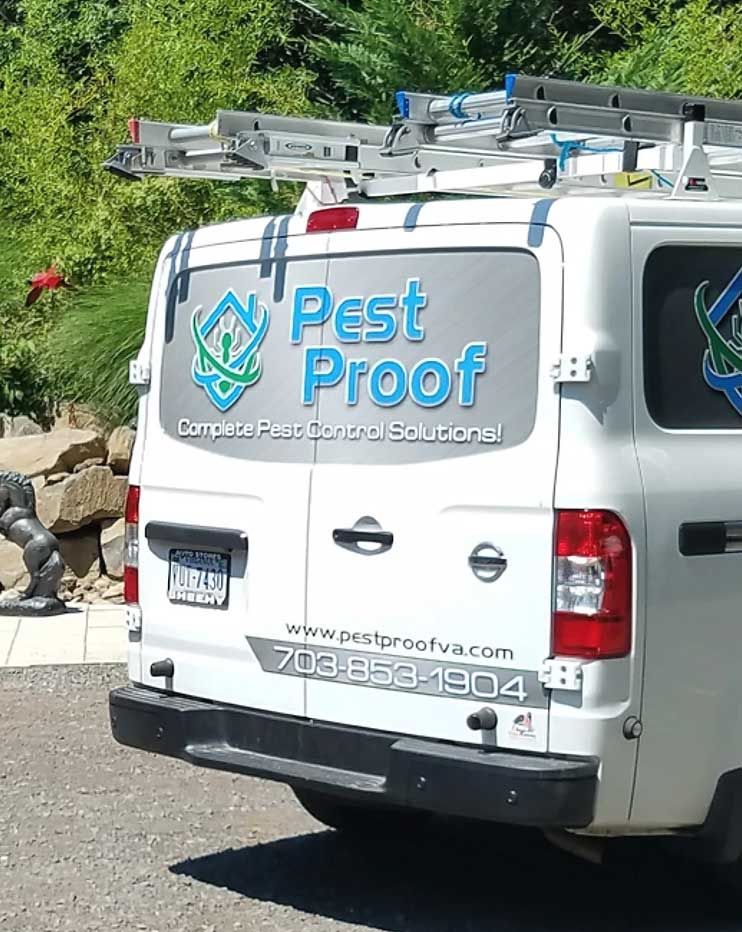Skunk Control In Manassas VA
Unlike other common invaders, notably raccoons and squirrels, skunks do not readily climb, and their entry is usually limited to ground-level invasion. Utilizing sunrooms, decks, porches, and patios as well as crawl spaces under homes. Skunks often gain access to these areas by entering through ductwork.
How Dangerous Is Skunk Spray To Dogs?
Of major concern to homeowners is skunk spraying under these areas resulting in odors in the home. This can be extreme and air handling units can quickly spread the scent throughout the home. Negative interactions can also occur with pets or homeowners themselves surprise an unsuspecting skunk.
Do not try to remove a skunk by yourself. You will need to contact the authorities in your area or hire professionals like Pest Proof Pest Management to come by and remove the skunk in the most ethical way possible.
Harmful Characteristics Of Skunks
When a skunk feels threatened, it will spray its attacker with its scent glands. The spray from the scent glands is known to cause skin irritation and sometimes temporary blindness. Skunks are not known for biting, but there have been recorded incidents where a skunk has done so, especially with the removal of the scent glands. If a skunk bites you, you will have to seek medical attention as soon as possible as skunks are vectors for the rabies disease. Rabies is very dangerous to humans and other animals. If not treated, it can be fatal.
How To Get Rid Of Skunks In Your Home
 Although some people have skunks as pets, this does not mean that one can approach any skunk they see. Most domesticated skunks have had the scent glands removed. Even with the scent gland removed a domesticated skunk will protect itself if threatened by biting. Avoid wild skunks. Do not try to remove a skunk by yourself.
Although some people have skunks as pets, this does not mean that one can approach any skunk they see. Most domesticated skunks have had the scent glands removed. Even with the scent gland removed a domesticated skunk will protect itself if threatened by biting. Avoid wild skunks. Do not try to remove a skunk by yourself.
You will need to contact the authorities in your area or hire professionals like Pest Proof Pest Management to come by and remove the skunk in the most ethical way possible.
General Information About Skunks
Skunks are mammals located in North and South America. A skunk’s terrible smell will always be associated with it. That is the reason many humans and animals avoid them. When they are not breeding, they are solitary animals. When the weather is too cold, Skunks will den up with other Skunks for warmth. They will den up but not hibernate. The females will den together in groups of up to 12, while the males will den alone. Skunks have a great sense of smell, but poor vision, they usually cannot see anything that is more than 10 feet away. This poor vision is the cause of many skunk deaths by vehicle traffic. Most Skunks only live one year, some may live up to 7 years. In captivity, a skunk can live almost ten years.
Skunks defend themselves by spraying when they are in fear. The scent gland produces a spray of sulfur made of mercaptans. These chemicals have a very offensive smell. The spray is a skunk’s primary defense and it is very effective, strong enough to ward off a bear. Most predators will not attack skunks because of this spray. A skunk has enough of the chemical for 5 to 6 uses and requires about ten days for them to produce more.
Because of this supply, skunks are very reluctant to use it all at once. They will instead warn surrounding predators by hissing and stomping their paws. A skunk’s predators are dogs, owls, wolves, foxes and badgers. Most of their predators will try and avoid skunks, so they don’t get sprayed, but there are reckless predators like the dogs and owls that will continue to attack a skunk even after being sprayed.
Skunks tend to mate in the spring. Skunks are polygynous which means the male will mate with multiple females. Before the female is ready to conceive, she burrows in the ground and creates a den to house her young. Skunk young are called Kits. Kits are born blind, deaf and with fur. Kits are weaned off after two months of being born but will stay with their mother until they are ready to mate, which is usually a year after birth. The mother is the primary caregiver to the Kits, as the father plays no role at all. A mother skunk will protect her young by spraying her notorious scent.
How To Identify Skunks
Skunks vary in size and their bodies are long and have short, muscled legs. Their paws have claws, which they use for digging. A skunk’s appearance is very recognizable and iconic. If you see an animal with black fur and a white stripe, you can mostly assume it is a skunk and will keep away.
The most common skunk is black and white. Some skunks are brown, gray and cream-colored. You may know a skunk is in your area because of the smell. A skunk’s spray is noticeable almost 5 miles downwind. If you do catch a whiff of a strong, strange odor, there may be skunks in your area.
Pest Proof Pest Management offers skunk removal services in the greater Manassas, VA area including Bristow and Gainesville and other surrounding areas. Give us a call today!
pest proof
management
Pest Control and Wildlife Removal for
Residential & Commercial
in Manassas, VA, Front Royal, VA, and
Fredericksburg, VA

